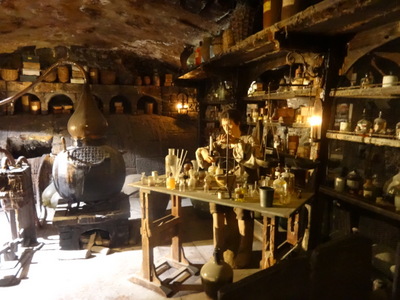
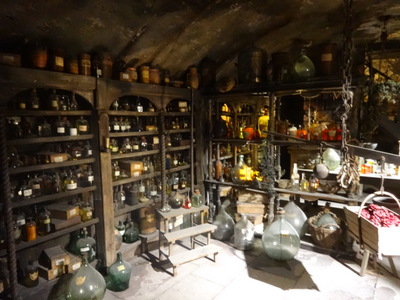 You enter the museum through a good-sized room that displays a sampling of the sort of thing you'll see inside; that part is free. Once you've bought your tickets, though, you get to see all the amazing stuff.
You enter the museum through a good-sized room that displays a sampling of the sort of thing you'll see inside; that part is free. Once you've bought your tickets, though, you get to see all the amazing stuff.Wednesday, 20 July 2016, Market, miniatures, and cinema in Lyon
Written 30 August 2016
I got up early, scarfed my (standard Ibis) breakfast, and headed for the market across the street, worried that if I didn't get there bright and early, the good stuff would all be over with. As it turns out, I need not have worried—it's not that kind of market. At first, I thought maybe I was too late, because only a few places were open, but then I realized they were still setting up; the market didn't really get underway until 9:30 a.m. or so. So I hung around, making circuit after circuit of the place, watching as more places opened and taking a zillion photos. Rather than try to fit them all in here, I've set them up on their own separate page, "hors série" as it were, which clicking "next page" at the bottom of this one will take you to. If you're not into markets, clicking "next page" at the bottom of that one will take you on to the following day.
Once I had spent as much time as I dared at the market (didn't want to spend so much time there that we gave the Museum of Miniatures and the Cinema short shrift), I went back across the street and collected David, and we set off, via metro, for the other side of the city. Our hotel was on the east side of the Rhône, the center of the city is on the long peninsula between the two rivers, north of their confluence, and the old town, and the museum, are on the west side of the Sâone, 3 or 4 km away.

 You enter the museum through a good-sized room that displays a sampling of the sort of thing you'll see inside; that part is free. Once you've bought your tickets, though, you get to see all the amazing stuff.
You enter the museum through a good-sized room that displays a sampling of the sort of thing you'll see inside; that part is free. Once you've bought your tickets, though, you get to see all the amazing stuff.
You start by going down to the cellar to see the full-size film sets, then work your way up to the fifth floor, following the helpful arrows that indicate the best order in which to visit the exhibits.
The two photos here are two of several full size reconstructed sets from the movie "Perfume: The Story of a Murderer." Mannekins are dressed as some of the character. These are the actual sets used in filming, which were taken down, moved to Lyon, and put back together by the original crew that did them for the film. It took a large crew working for months to make all the stuff—for example, they had to blow some thousands of itty bitty bottles to furnish the shelves.
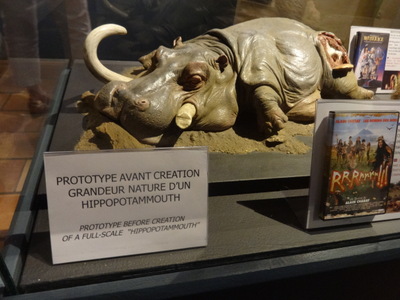
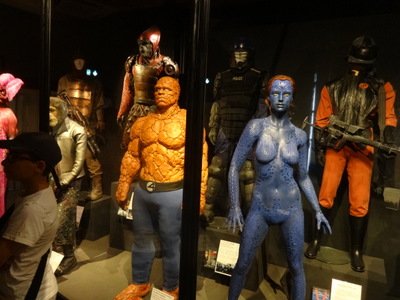 Dan Ohlmann, whose museum this is, has assembled an enormous collection of film props and prosthetics. He's constantly acquiring more—much of the museum had been rearranged since I was last there, to place more emphasis on the film side of things and less on the side of miniatures produced as art objects. At first, miniatures and cinema seem an odd combination, but where they meet is the miniatures constructed for use in cinematic special effects.
Dan Ohlmann, whose museum this is, has assembled an enormous collection of film props and prosthetics. He's constantly acquiring more—much of the museum had been rearranged since I was last there, to place more emphasis on the film side of things and less on the side of miniatures produced as art objects. At first, miniatures and cinema seem an odd combination, but where they meet is the miniatures constructed for use in cinematic special effects.
At the left here is a scale model made as a study for the full-sized "hippopotammouth" used in a French film called RRRrrrr!!!, described as "a comedy with Alain Chabat." From the poster, I gather that it featured cave men. In the upper right corner of the photo, you can see the poster for Beetlejuice; something from that movie was the next item over.
At the right are the prosthetic suits of some of the characters in a superhero movie, The Fantastic 4 and the Rise of the Silver Surfer. I think the purple one is called "Storm"; she may be from X-men 2. To the left of them, you can see a costume from one of the Planet of the Apes movies. Throughout, except for a few that are labeled otherwise, the items on display are those that were actually used in the films.
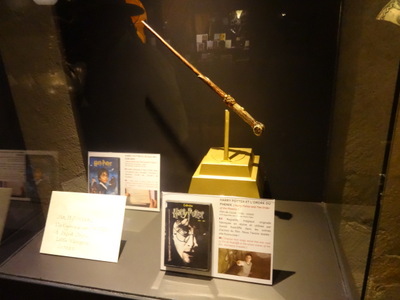
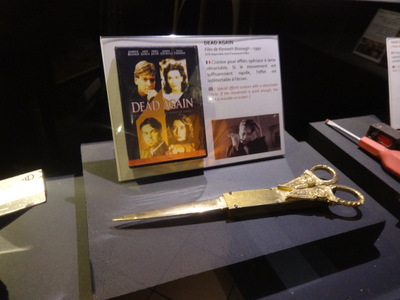 Here, at the left, we have the actual wand used by Harry Potter in Order of the Phoenix; it's made of resin but supposed to look like wood. The label says "We tested it; it works!"
Here, at the left, we have the actual wand used by Harry Potter in Order of the Phoenix; it's made of resin but supposed to look like wood. The label says "We tested it; it works!"
At the right is the pair of ornate scissors that featured prominently in Kenneth Branaugh's Dead Again. They're turned revelatory-side-up so that you can see the mechanism that lets the blades slide into the handle when it's used to stab someone.
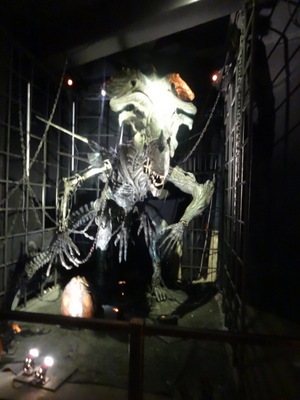
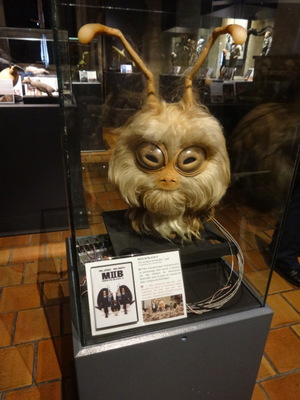 At the left here is the original animatronic "alien mother" from the Alien movies. Four minutes out of every eight, she roars, slavers, and makes threatening gestures.
At the left here is the original animatronic "alien mother" from the Alien movies. Four minutes out of every eight, she roars, slavers, and makes threatening gestures.
At the right is a little furry creature from Men in Black II.
The collection of movie props and prosthetics is huge—the Mrs. Doubtfire face that Robin Williams wore, the severed Head of Scully from a nightmare sequence in The X Files, guns from Bonanza, all sorts of prosthetic blood and gore, fake snakes that were mixed in with the real ones in Indiana Jones, dinosaurs from Jurassic Park, photos of a wonderful suit worn by a super-slim actor that incorporated spring-loaded stilts and arm extensions to give the impression of an eight-foot werewolf kind of creature (from Underworld), a prosthetic pregnancy belly from House, any number of gruesome mutilation prosthetics from the Terminator movies. Here and there a room full of particularly gruesome stuff (e.g., blown-up dead bodies) would be labeled "not for children or the very sensitive."
In addition, though, photos, text, slides, and video gave huge amounts of information about how special effects are achieved (e.g., how did they make it look as though half of Arnold Schwarzeneger's head was missing, in the days before CGI?). I really liked the film about making of the scenes from The Aviator where Howard Hughes crashes his plane into houses in L.A. and the material on how the special effects in Inception were done. I was astonished to learn that a version of The Three Musketeers has been made that involved a wooden sailing ship suspended below a football-shaped hot-air balloon—the model was about six feet long. We were enthralled.
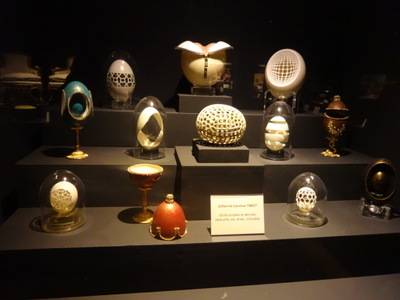
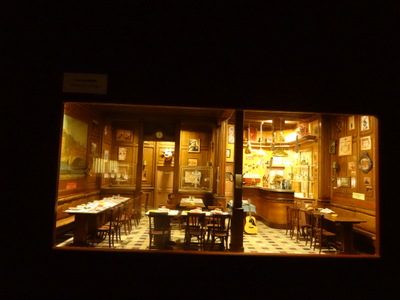 Then we came to the miniatures made as works of art. Here at the left are objects carved from the shells of real eggs (in this photo, of ostrich, goose, emu, and crocodile).
Then we came to the miniatures made as works of art. Here at the left are objects carved from the shells of real eggs (in this photo, of ostrich, goose, emu, and crocodile).
At the right is the interior of a bistro, by Dan Ohlmann himself, I think. Note the paintings on the wall (the size of postage stamps), the snapshots tacked up behind the bar (even smaller), the napkins and glassware, and the tiny little guitar. Wonderful!
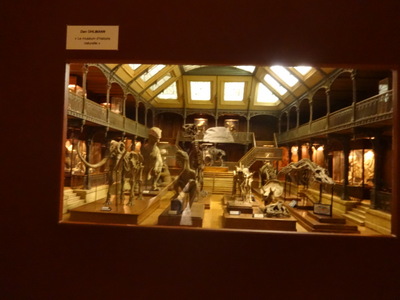
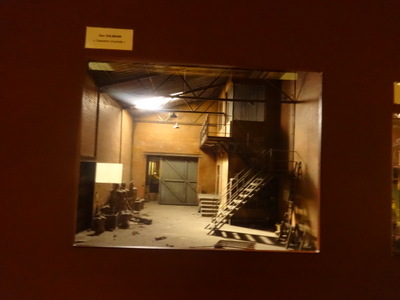 Here are two more of Ohlmann's. At the left, his famous rendering of the (old arrangement of) the dinosaur hall of London's Museum of Natural History. At the right, an alleyway with fire escape that appealed to him.
Here are two more of Ohlmann's. At the left, his famous rendering of the (old arrangement of) the dinosaur hall of London's Museum of Natural History. At the right, an alleyway with fire escape that appealed to him.
Ohlmann likes dusty, neglected, and abandoned spaces and has done breathtaking miniatures of, e.g., old libraries, the Paris ballet's empty rehearsal hall, an old barn with a broken down antique car in it. I could stare forever. Right next to the miniature of the alleyway is a photo of the same thing, but with Ohlmann's hand coming in through the half-open doorway at the back, for scale.
Besides scenes, the museum displays thousands of other sorts of miniatures: 1/12 scale fine furniture, tiny hand-made shoes, all kinds of miniature food, power tools, dishes and glassware, paper cuts (like the ones Lucretia Beerli-Bieler does, but each one no bigger than a postage stamp). There's even a section of miniatures so tiny you can't really see them without magnification, like a little train of carved camels, all standing in line inside the eye of a needle! It's displayed under a big magnifying glass, so that you can tell what you're looking at. I really can't recommend this museum highly enough! Just Google up its website to see much better photos than I could get.
Note that tickets are good all day—you can go out, find lunch in the neighborhood, and go back in.
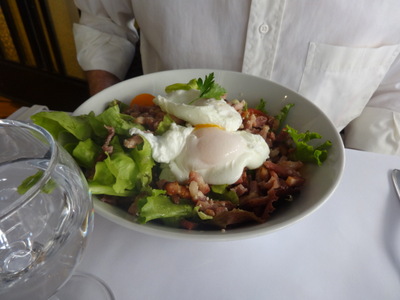
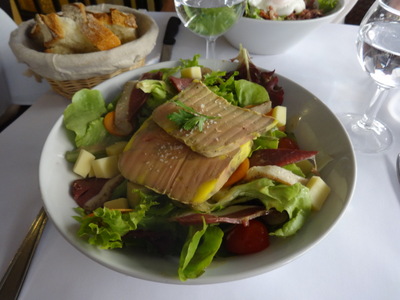 We did, in fact, find lunch in the neighborhood, at Le Panier du Chef (The Chef's Basket), in the Place Neuve Saint-Jean, where we have also found lunch in the past. David's salad was topped with lardons and poached eggs, mine with foie gras and duck-breast ham.
We did, in fact, find lunch in the neighborhood, at Le Panier du Chef (The Chef's Basket), in the Place Neuve Saint-Jean, where we have also found lunch in the past. David's salad was topped with lardons and poached eggs, mine with foie gras and duck-breast ham.
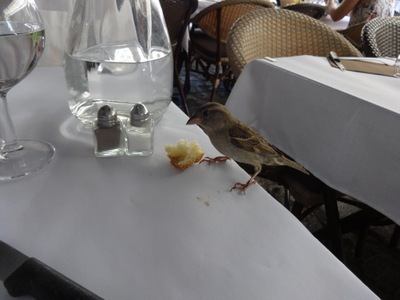
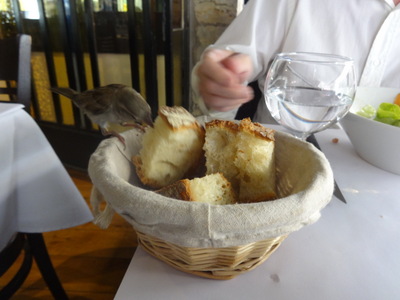 The salads were good, but the real fun was the birds. The local Passer domesticus (house sparrows; they're really finches, but the name "house finch" is taken, and the Brits have always called them sparrows) are the boldest I've ever encountered. We're used to having them hopping around under the chairs at sidewalk eateries, scavenging dropped crumbs, but these came right up on the tables—and not just empty tables either!
The salads were good, but the real fun was the birds. The local Passer domesticus (house sparrows; they're really finches, but the name "house finch" is taken, and the Brits have always called them sparrows) are the boldest I've ever encountered. We're used to having them hopping around under the chairs at sidewalk eateries, scavenging dropped crumbs, but these came right up on the tables—and not just empty tables either!
As soon as I set out the little chunk of bread in the left-hand photo, a female was there, trying to tear pieces off it. Meanwhile, on the other side of the (very small) table, another was doing her best to get a whole slice out of our bread basket. She probably would have made it, too, if David hadn't back-handed her off the table.
Even the males, usually much more timid than the females, came right up close. It was a hot day, and many of the birds were panting with their mouths open and trying to drink from tiny water spills between the bricks, so I tried dunking little chunks of bread in my water glass before setting them out—that really pulled 'em in!
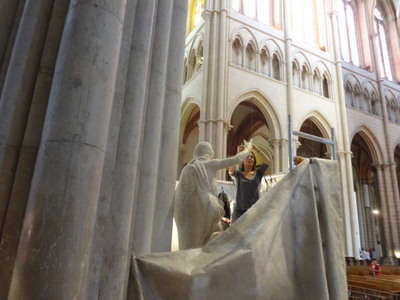
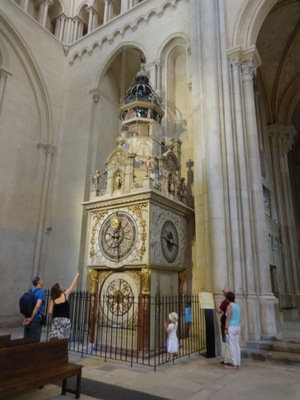 On our way back to the metro, we stopped in to look around the Cathedral of St. John the Baptist (the huge, gleaming white edifice of—shall we say—eclectic style that dominates the city from the top of the Fourvière hill is only a basilica; the cathedral is down on the river bank). The photo at the left is of a woman who was painstakingly cleaning one of the sculptures.
On our way back to the metro, we stopped in to look around the Cathedral of St. John the Baptist (the huge, gleaming white edifice of—shall we say—eclectic style that dominates the city from the top of the Fourvière hill is only a basilica; the cathedral is down on the river bank). The photo at the left is of a woman who was painstakingly cleaning one of the sculptures.
At the right is the cathedral's amazing astronomical clock. Somewhere, I remember doing a full write-up of all its myriad features, but that visit to Lyon was before I started keeping blogs, so it must have been in a Christmas letter. I'll see if I can dig it out sometime . . .
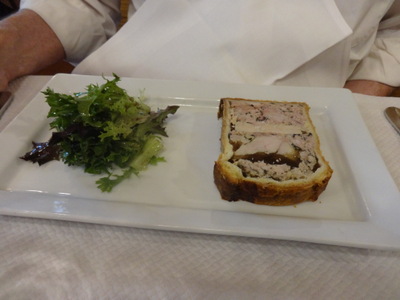
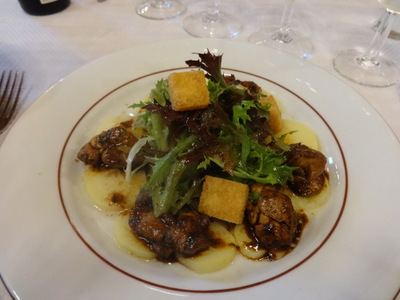 Dinner was at Daniel et Denise, an easy walk from our hotel. It's one of three scattered around the city, and it specializes in traditional Lyonnaise bistro food.
Dinner was at Daniel et Denise, an easy walk from our hotel. It's one of three scattered around the city, and it specializes in traditional Lyonnaise bistro food.
David started with pâté en croute, and very good it was, too. The dark areas are the places where richly flavored meat aspic has filled voids left by shrinkage during baking.
I chose lamb sweetbreads napped with a rich meat glaze. They rested on slices of warm potato, and both dishes came with a little bit of salad with vinaigrette (mine with a couple of croutons).
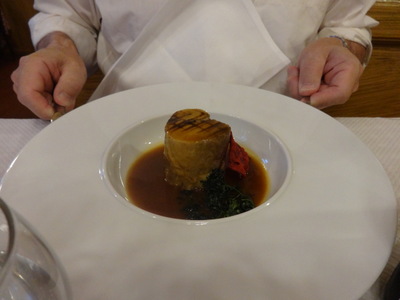
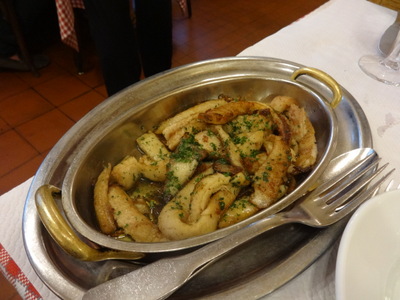 David's main course was one of the specials of the night—I think it was boned, rolled, and slowly cooked pork shoulder. He pronounced it excellent but too large.
David's main course was one of the specials of the night—I think it was boned, rolled, and slowly cooked pork shoulder. He pronounced it excellent but too large.
I jumped at the chance to have "gras double sauté à la Lyonnaise," Lyonnaise sautéed tripe ("gras double," meaning "fat double," is a particularly choice section of tripe), served in long strips. It was great, but again the portion was huge—I could only finish about 2/3 of it.
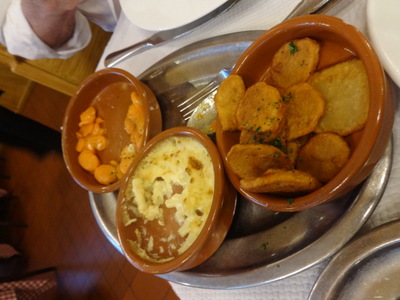
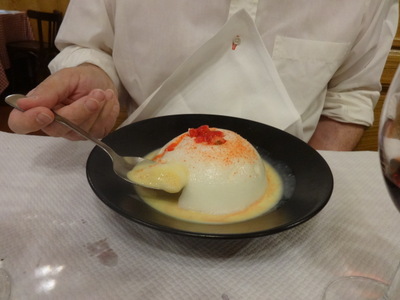 The side dishes were fried potatoes, mac and cheese, and buttered carrots. The mac and cheese was made, of course, in the European fashion with a Swiss type cheese rather than cheddar.
The side dishes were fried potatoes, mac and cheese, and buttered carrots. The mac and cheese was made, of course, in the European fashion with a Swiss type cheese rather than cheddar.
David's dessert was "floating island," soft meringue floating on a pool of boiled custard—French comfort food, which David pronounced to be just what he wanted. On top were a few sugared nuts, a beloved symbols of summertime to the French. Note that the establishment's napkins are equipped with button holes so that you can button them to the front of your shirt for better coverage and protection.
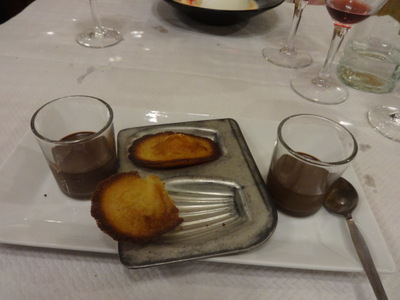
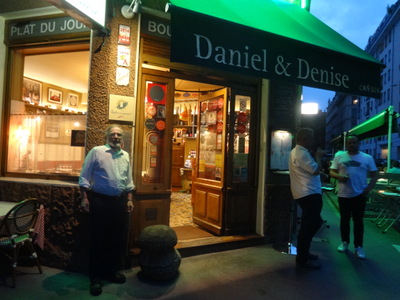 Uncharacteristically, I ordered the chocolate dessert, which consisted of warm madeleines and soft chocolate sauce for dipping. Yummy! I used about half the chocolate they seemed to think that two large madeleines required, and the combination was outstanding.
Uncharacteristically, I ordered the chocolate dessert, which consisted of warm madeleines and soft chocolate sauce for dipping. Yummy! I used about half the chocolate they seemed to think that two large madeleines required, and the combination was outstanding.
Finally, here's David standing outside the restaurant as we said goodby to French dinners for another year. Tomorrow, back to Tallahassee.